Weekly recap
US stocks rose for a third straight week, reaching multiple record highs before falling back on Wednesday after the Federal Reserve cut interest rates by 25 basis points, but warned that a December rate cut was not a foregone conclusion. As a result, the bond markets sold off, and the market lowered December rate cut expectations to 70% from 90%. Stock indices slipped, and the USD rose.
Last week’s high-stakes meeting between President Trump and China’s Xi Jinping went well but stopped short of an all-out trade deal. Trump lowered tariffs on Chinese imports to 47% from 57% in exchange for China to buy soybeans, keep rare earth flowing, and crack down on fentanyl trafficking. This eased trade tensions, which should reassure investors that the relationship is on a more stable footing.
Corporate earnings have been better than expected, showing that profitability remains resilient. Five Magnificent seven firms reported earnings. Meta and Microsoft fell sharply amid concerns over AI spending, while Alphabet, Amazon, and Apple impressed, lifting indices such as the Nasdaq 100 at the end of the week. Earnings will continue this week.
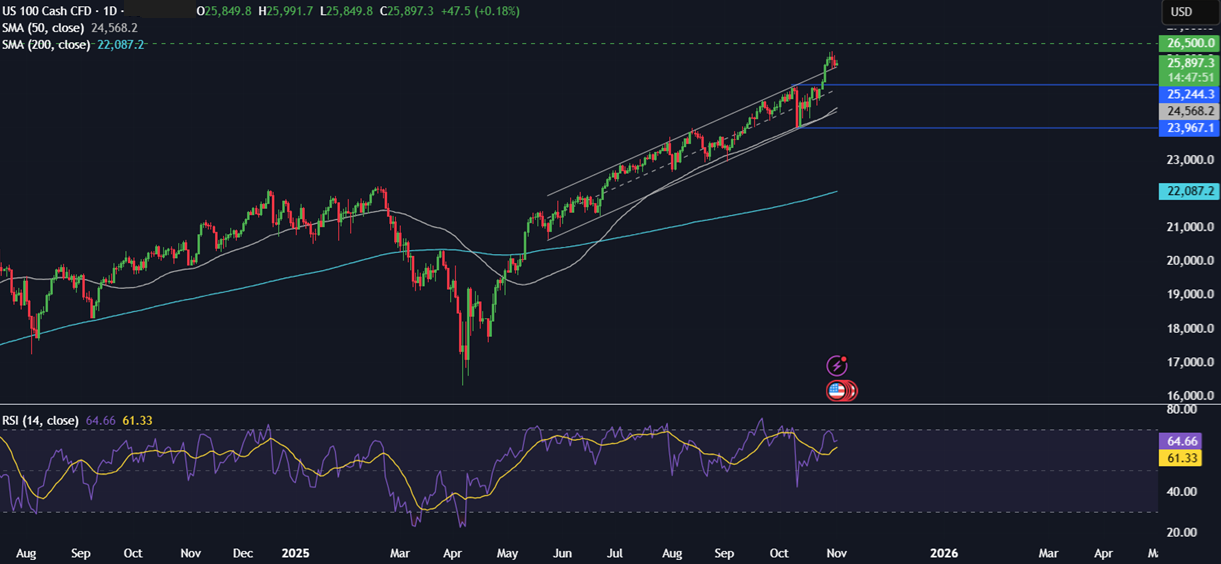
OPEC+
OPEC+ agreed to increase oil production by 137k barrels per day, in line with expectations, and then pause in the first quarter of 2026, moderating plans to regain market share due to rising fears of a supply glut. OPEC+ has lifted output targets by 2.9 million barrels a day, or around 2.7% of global supply, since April, but has slowed the pace in recent months owing to concerns about oversupply. Oil prices are rising and hold over $60.00 following the meeting.
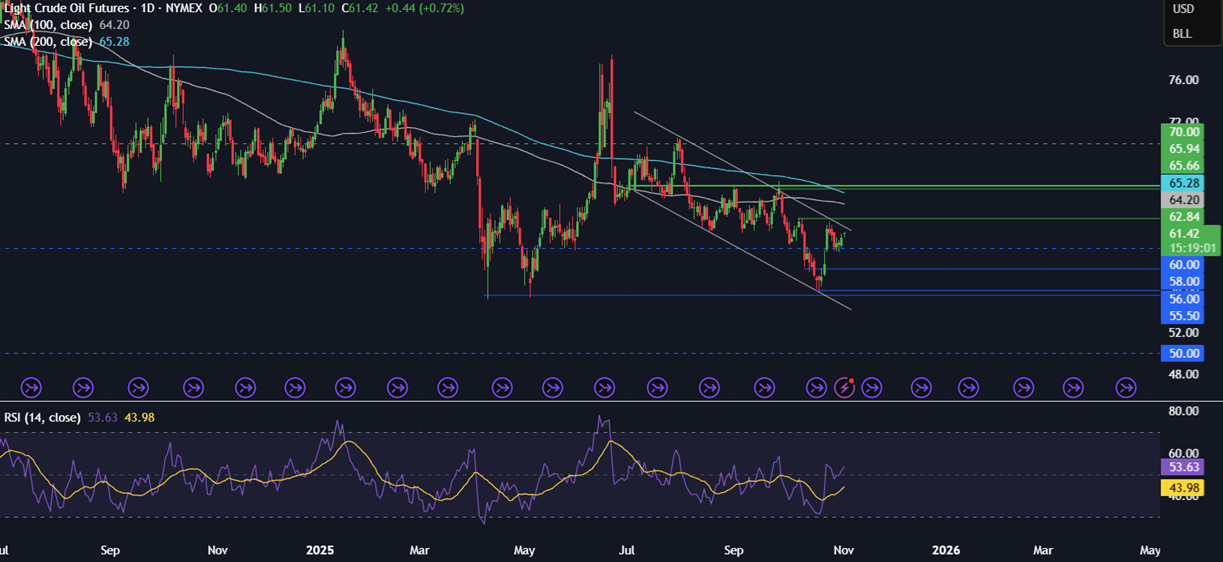
US ISM manufacturing PMI (Monday)
Given the lack of U.S. government data owing to the ongoing shutdown, ISM PMIs will take on a more important role than usual, with the manufacturing PMI due on Monday and the services PMI on Wednesday. Using the S&P Global PMI data to shape expectations, manufacturing rose to 52.2 in October, up from 52 previously, while services rose to 55.2, defying expectations of a decline, and rose from 54.2 in September. This report noted that business activity growth in October was the second fastest pace this year and was accompanied by the largest rise in new business seen in 2025 so far.
The market will look to see if this trend shows in the ISM PMIs. The employment subcomponent showed that employment increased modestly but weakened in manufacturing. With inflation still above target, attention will be on prices paid, particularly in the service sector, which is not directly linked to tariffs and could give more information about inflation in the economy. Weak data could fuel expectations of a Fed rate cut and lift stocks such as the Dow Jones Industrial Average.
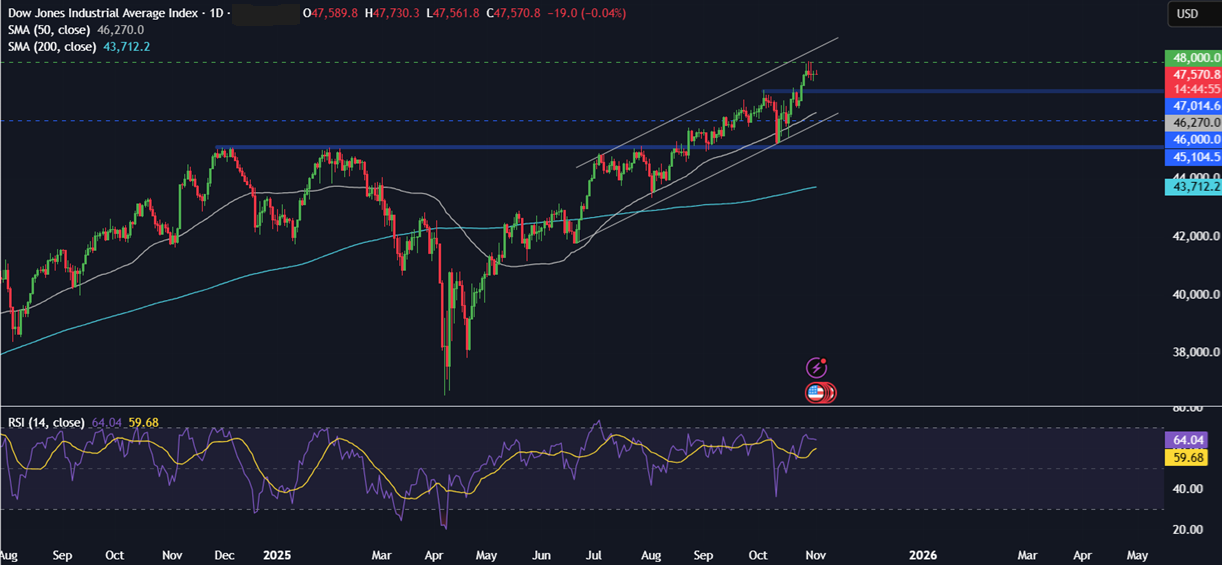
RBA rate decision (Tuesday)
The RBA will announce its decision on November 4, with expectations that policymakers will leave THE Cash Rate at the current level of 3.6%. The market is 92% convinced that rates will be left unchanged. While some economists had previously anticipated one more cut this year, rising inflation will likely keep the RBA cautious. The latest CPI report showed inflation was hotter than expected, prompting the unwinding of rate-cut expectations even as unemployment rose to 4.5% from 4.3%. At the previous meeting, the RBA left rates unchanged, with the Board judging that risks were broadly balanced and providing no guidance. A more hawkish-than-expected RBA could lift AUD/USD.
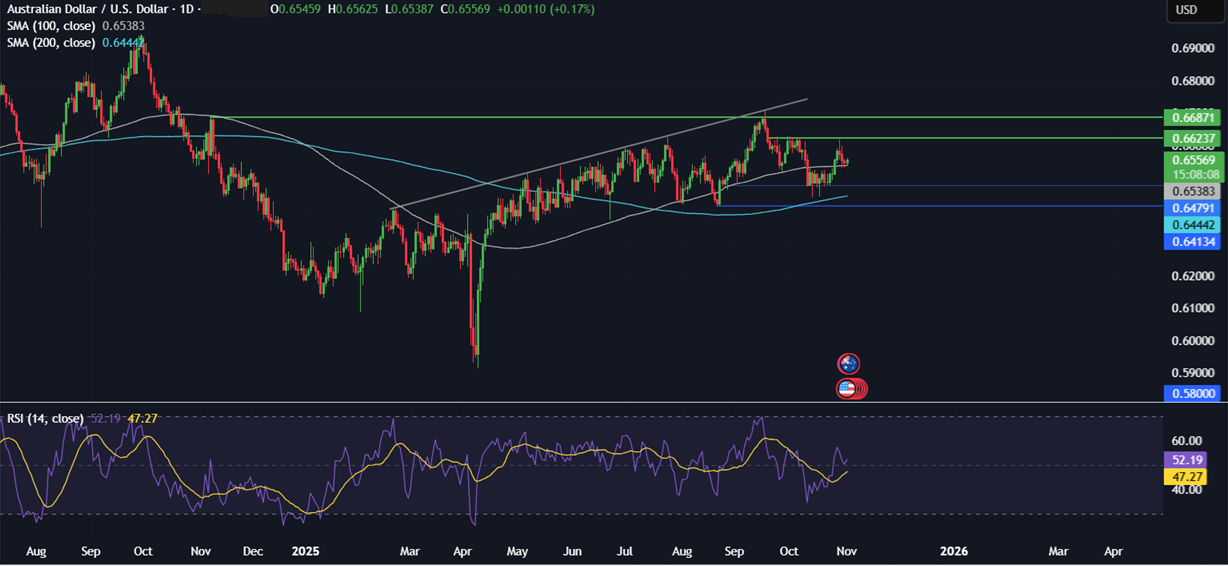
ADP payrolls (Wednesday)
In the absence of BLS data due to the ongoing US government shutdown, the market is having to make do with third-party reports as to the health of the US economy. So far, it hasn’t been too challenging to assess the health of the economy using ADP payrolls this week, following the US CPI release last week. The Fed cited the labour market slowdown as a reason for cutting rates. The most recent ADP payroll report for September showed -32k jobs were lost, making it the second straight month of a negative print. In fact, over the past 4 months, there’s been only one positive month: July, with 104K jobs added. This is a slowdown from the first five months of the year, which supports the Fed’s view of a cooling jobs market. Expectations are for 25k jobs added in October. Weaker-than-forecast ADP payroll data could boost Fed rate-cut expectations and pull the USD lower, dragging USD/JPY lower.
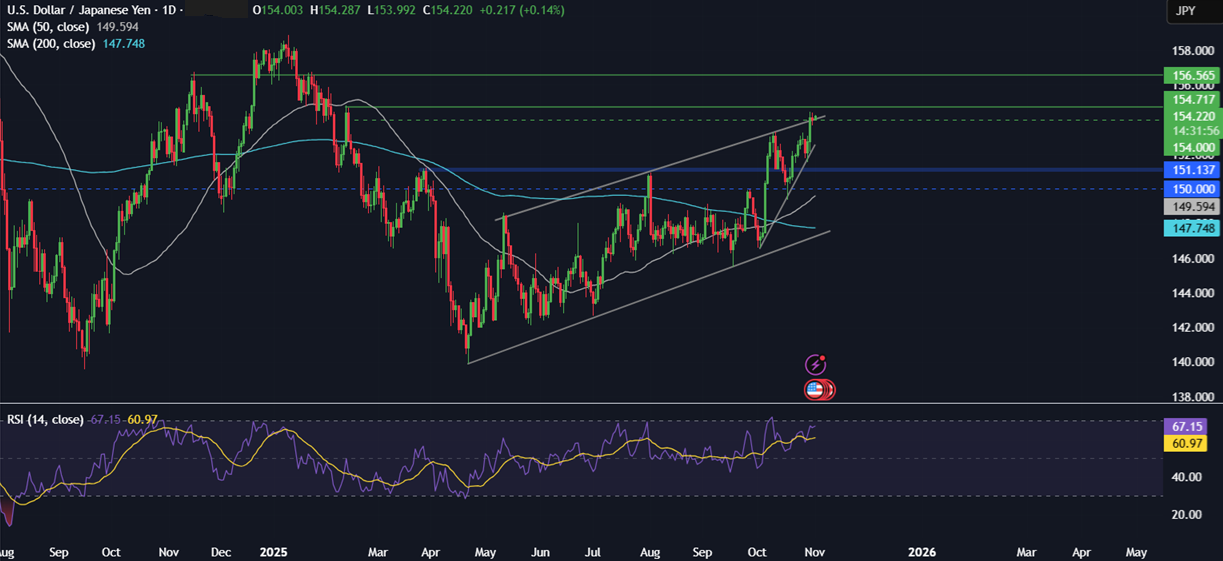
US Supreme Court Tariff Hearing (Wednesday)
US Supreme Court will hear arguments in the case challenging President Trump’s reciprocal tariff policy. This hearing follows a federal court ruling that Trump exceeded his authority under the International Emergency Economic Powers Act (IEEPA) in imposing tariffs on several trading partners, including Mexico, Canada, and China. The court is expected to consider whether the IEEPA allows the president to impose tariffs beyond its intended scope. Tariffs will remain in place until the court’s final decision, expected early next year. According to Bloomberg, there is currently a 60% chance the court will rule against Trump, leaving the US government exposed to refund claims that could hit the US economy. The market is unlikely to react until the final decision is made. Gold is a good monitor for market sentiment.
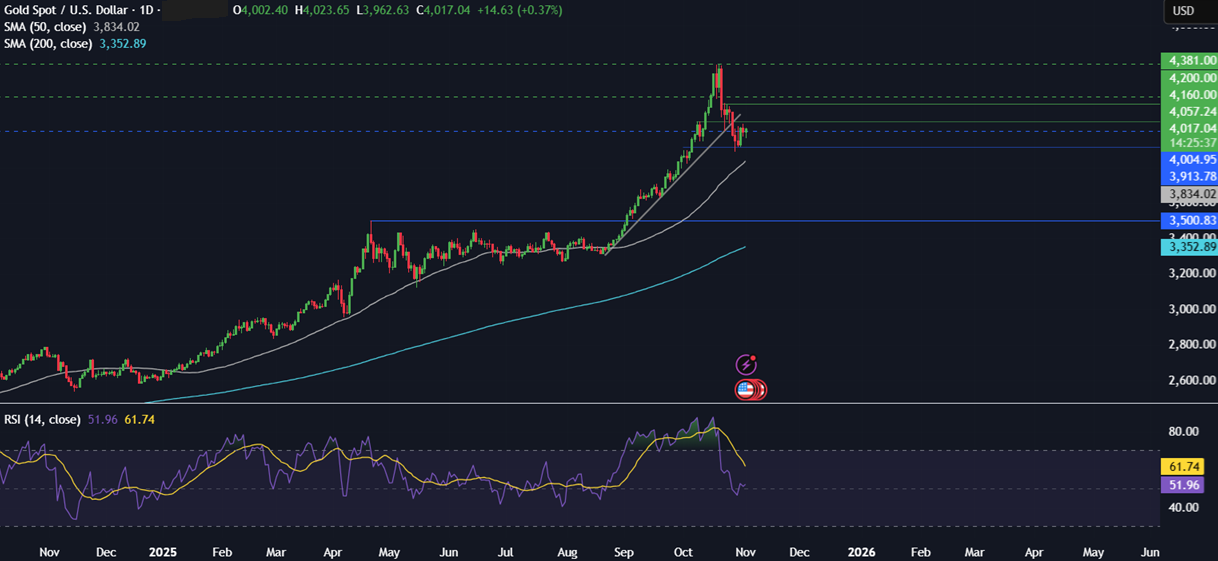
BoE rate decision (Thursday)
The BoE will announce its rate decision on Thursday at 12 GMT, and while no rate cut is expected, the market is pricing in just a 31% chance of a rate reduction -the decision may not be as clear-cut as it was with a 6-3 vote split. The recent September CPI report came in cooler than expected, remaining unchanged at 3.8% failing to hit the 4% forecast. While food inflation remains high at 5.1%, core inflation remained unchanged at 3.5%. These levels are above the BoE’s 2% target, which, combined with the uncertainty surrounding the Chancellor’s November 26 budget, means policymakers will see little reason to move just yet. The rate decision comes as the pound has dropped sharply against peers this week amid rising expectations that the Chancellor will hike taxes, which could slow the economy, forcing the BoE to cut rates more aggressively early next year. A dovish-sounding BoE could pull GBP/USD lower.

Canadian unemployment (Friday)
The jobs report will reveal how the labour market is holding up amid elevated trade tensions between the US and Canada. The BoC noted at last week’s meeting that the labour market remains soft. While employment rose in September, the gains came after two months of sizeable losses, and job losses rose in trade-sensitive sectors. The unemployment rate was at 7.1% and wage growth had slowed. The BoC cut rates at the meeting, taking rates to 2.25%, the bottom end of the neutral rate, while also signalling that it was done with rate cuts. As a result, this report is unlikely to have much impact on BoC expectations; therefore, the effect on USD/CAD could be limited.
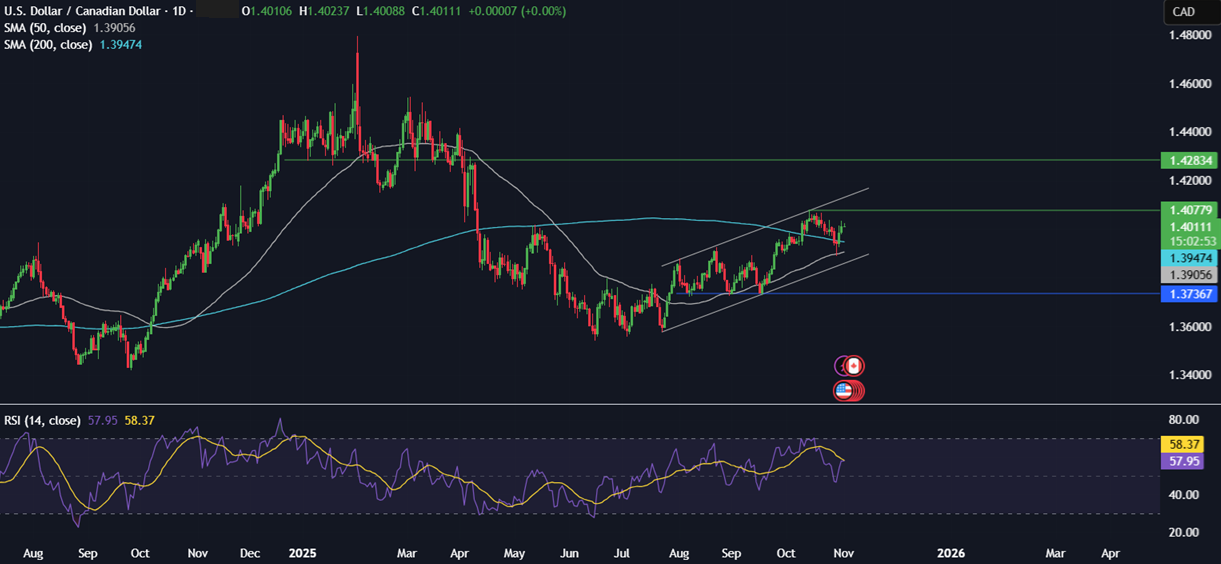
Chinese trade balance (Friday)
Chinese trade balance last month showed a narrower surplus as both exports and imports surprised to the upside. Exports grew by 8.3% year on year, up from 4.4% in August, a solid performance that few expected in the midst of the trade war. Exports are holding up better than expected, boosted by stronger demand from the rest of the world, which offsets the US drag. Meanwhile, imports were the largest surprise, reaching a 17-month high of 7.4% up from 1.3% in August. This was a surprise given recent signs of softness in domestic demand. However, it’s worth noting that the upcoming data could prove to be sale given the recent trump XI meeting, which helped to de-escalate trade tensions further and reduce immediate policy uncertainty, which likely impacted import-export behaviour in previous months. Signs of strong export and import growth could boost the Hang Seng.

Trading involves risk.
The content provided here is for informational purposes only. It is not intended as personal investment advice and does not constitute a solicitation or invitation to engage in any financial transactions, investments, or related activities. Past performance is not a reliable indicator of future results.
The financial products offered by the Company are complex and come with a high risk of losing money rapidly due to leverage. These products may not be suitable for all investors. Before engaging, you should consider whether you understand how these leveraged products work and whether you can afford the high risk of losing your money.
The Company does not accept clients from the Restricted Jurisdictions as indicated in our website/ T&C. Some services or products may not be available in your jurisdiction.
The applicable legal entity and its respective products and services depend on the client’s country of residence and the entity with which the client has established a contractual relationship during registration.




